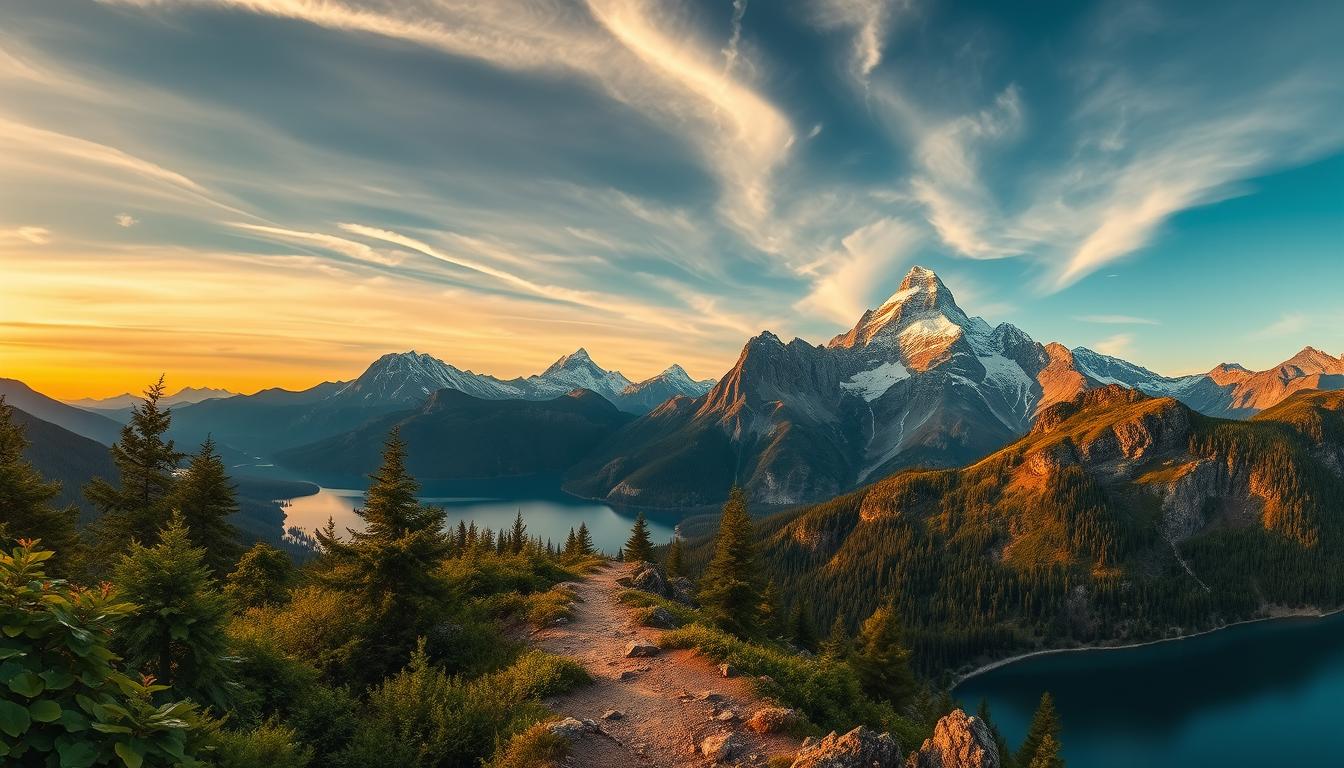Discover the thrill of outdoor experiences that await you in the great outdoors. From hiking and camping to kayaking and cycling, there’s a wealth of activities to suit every interest and adventure level.
Exploring the outdoors not only provides a chance to connect with nature but also offers a unique opportunity to challenge yourself and create lasting memories. Whether you’re a seasoned outdoor enthusiast or just starting to explore, having the right outdoor tips can make all the difference.
Key Takeaways
- Variety of outdoor activities for all interests and skill levels
- Opportunities to connect with nature and challenge yourself
- Importance of having the right outdoor tips for a successful adventure
- Creating lasting memories through outdoor experiences
- Outdoor activities suitable for both beginners and seasoned enthusiasts
The Wonders of The Outdoors
As we navigate the challenges of modern life, the outdoors offers a refreshing respite, rich in opportunities for exploration and rejuvenation. Engaging in outdoor activities allows individuals to disconnect from the stresses of daily life and reconnect with the natural world.
Physical and Mental Health Benefits
Outdoor activities have a profound impact on both physical and mental health. Being in nature has been shown to reduce symptoms of anxiety and depression, improve mood, and even lower blood pressure.
Stress Reduction and Mood Enhancement
Spending time outdoors can significantly reduce stress levels by providing a calming environment that distracts from daily worries. The exposure to natural light and the sounds of nature contribute to an enhanced mood and overall sense of well-being.
Cardiovascular and Immune System Benefits
Engaging in outdoor activities such as hiking or cycling can improve cardiovascular health by strengthening the heart and increasing circulation. Being outdoors also exposes individuals to vitamin D through sunlight, which is essential for a healthy immune system.
Connecting with Nature in Modern Times
In today’s digital age, it’s easier than ever to stay connected with nature, even in urban environments. Parks, green spaces, and outdoor recreational areas provide ample opportunities for individuals to engage with the outdoors.
Digital Detox Opportunities
Outdoor activities offer a chance to disconnect from digital devices and engage in a digital detox. This break from technology can lead to improved mental clarity and a sense of calm.
Building Environmental Awareness
Participating in outdoor activities fosters a deeper appreciation and understanding of the natural world. This increased environmental awareness can inspire individuals to adopt more sustainable practices and contribute to conservation efforts.
Essential Gear for Outdoor Adventures
Whether you’re hiking, camping, or exploring, the right gear can make or break your outdoor experience. Having the right equipment is crucial for a safe, enjoyable, and successful adventure.
All-Weather Clothing Essentials
Outdoor clothing should be versatile and capable of handling various weather conditions. Layering is key to maintaining comfort across different temperatures.
Layering Techniques for Temperature Control
Layering involves wearing multiple layers of clothing that can be added or removed as needed. This technique helps in regulating body temperature. A typical layering system includes a base layer for moisture-wicking, a mid-layer for insulation, and an outer layer for protection against the elements.
Rain and Sun Protection
Rain protection is vital, and a waterproof jacket is a must-have. Similarly, protection from the sun’s harmful rays is crucial. A hat, sunglasses, and sunscreen with a high SPF are essential items for any outdoor adventure.
Footwear for Different Terrains
The right footwear can significantly impact your outdoor experience. Different terrains require different types of footwear, from hiking boots for rugged trails to trail running shoes for smoother paths.
Hiking Boot Selection and Fit
When selecting hiking boots, consider the terrain, the length of your hike, and your personal comfort. A good fit is crucial; boots should be comfortable and provide adequate support.
Caring for Your Outdoor Footwear
Proper care can extend the life of your footwear. Cleaning your boots regularly and applying waterproofing treatments can help maintain their quality and performance.
Navigation Tools and Technology
Navigation is a critical aspect of outdoor adventures. While technology has provided us with advanced tools, traditional methods are still valuable.
Maps, Compasses, and GPS Devices
Understanding how to use a map and compass is fundamental. GPS devices offer additional precision and are particularly useful in unfamiliar territories.
Battery Conservation Strategies
For GPS devices and other electronic gear, conserving battery life is essential. Turning off devices when not in use and carrying spare batteries can help ensure you stay on track.
| Gear | Purpose | Key Features |
|---|---|---|
| Layering Clothing | Temperature Regulation | Moisture-wicking, insulation, waterproof |
| Hiking Boots | Foot Protection and Support | Waterproof, ankle support, good tread |
| GPS Devices | Navigation | Accuracy, battery life, waterproofing |
Planning Your Outdoor Excursion
Embarking on an outdoor adventure requires meticulous planning to ensure a safe and enjoyable experience. Whether you’re hiking, camping, or engaging in other outdoor activities, a well-thought-out plan is crucial.
Researching Your Destination
Before you head out, researching your destination is vital. This involves gathering information about the terrain, climate, and potential hazards.
Finding Reliable Trail Information
Look for trustworthy sources such as official park websites or outdoor enthusiast forums to find detailed trail information. This can include trail maps, difficulty levels, and any specific regulations.
Understanding Permit Requirements
Some areas require permits for entry or camping. Understanding these requirements in advance can prevent last-minute complications.
Weather Considerations
Weather can significantly impact your outdoor experience. Checking forecasts and being prepared for changing conditions is essential.
Reading Weather Forecasts
Learn how to interpret weather forecasts to anticipate potential weather conditions during your trip.
Planning for Weather Changes
Pack accordingly and have contingency plans in place for unexpected weather changes.
Creating Flexible Itineraries
A flexible itinerary allows you to adapt to changing circumstances while still making the most of your outdoor experience.
Setting Realistic Daily Goals
Be realistic about what you can accomplish each day, taking into account your group’s abilities and the terrain.
Building in Buffer Time
Include buffer time in your itinerary to account for unexpected delays or changes in plans.
Effective planning is the backbone of a successful outdoor excursion. By researching your destination, considering the weather, and creating a flexible itinerary, you can ensure a memorable and enjoyable experience.
| Planning Aspect | Description | Importance Level |
|---|---|---|
| Researching Destination | Gathering information about the terrain, climate, and potential hazards. | High |
| Weather Considerations | Checking forecasts and preparing for changing weather conditions. | High |
| Flexible Itineraries | Creating plans that can adapt to changing circumstances. | Medium |
Hiking Fundamentals for Beginners
Hiking is an excellent way to connect with nature, and with the right knowledge, beginners can hit the trails with confidence. As a beginner, it’s essential to understand the basics to ensure a safe and enjoyable experience.
Choosing the Right Trail
Selecting a trail that matches your fitness level and experience is crucial. Trails are often rated by difficulty, taking into account factors like terrain, length, and elevation gain.
Understanding Trail Difficulty Ratings
Trail difficulty ratings are usually categorized as easy, moderate, or difficult. Understanding these ratings helps you choose a trail that suits your abilities.
Matching Trails to Your Fitness Level
Be honest about your fitness level when choosing a trail. If you’re just starting out, opt for easier trails and gradually move to more challenging ones as your fitness improves.
Pacing Yourself on the Trail
Pacing is key to enjoying your hike and avoiding exhaustion. It’s not just about how fast you walk, but also about maintaining a comfortable rhythm.
Proper Hiking Rhythm and Breathing
Developing a steady breathing rhythm can help you maintain a consistent pace. Practice deep, controlled breathing to enhance your hiking experience.
Rest and Hydration Strategies
Regular breaks for rest and hydration are vital. Drink water regularly and take breaks in shaded areas to avoid dehydration and heat exhaustion.
Trail Etiquette and Leave No Trace Principles
Understanding and practicing trail etiquette and Leave No Trace principles are crucial for preserving the natural environment.
Right-of-Way Guidelines
Knowing who has the right of way on the trail helps prevent accidents. Generally, hikers going uphill have the right of way.
Minimizing Your Footprint
Leave No Trace principles emphasize minimizing your impact on the environment. Stay on designated trails, avoid littering, and respect wildlife habitats.
By following these hiking fundamentals, beginners can enjoy a safe and fulfilling hiking experience. Remember, the goal is to enjoy nature and challenge yourself in a positive way.
Camping Skills Everyone Should Master
Mastering camping skills is essential for a safe and enjoyable outdoor experience. Whether you’re a seasoned camper or just starting out, having the right skills can make all the difference in your adventure.
Selecting the Perfect Campsite
Choosing the right campsite is crucial for a comfortable and enjoyable camping experience. Several factors come into play when selecting a campsite, including ground conditions, access to water, and protection from the elements.
Assessing Ground Conditions
The ground should be relatively flat and dry. Avoid areas with standing water or where water tends to collect. Look for a spot with good drainage to ensure you stay dry in case of rain.
Considering Water and Wind Factors
Proximity to a water source is important, but be mindful of the risks associated with flooding. Additionally, consider the direction of the wind to position your campsite in a sheltered location. A well-chosen campsite can significantly enhance your camping experience.
| Factor | Ideal Condition | Why It Matters |
|---|---|---|
| Ground Condition | Flat and Dry | Prevents water accumulation and ensures comfort |
| Water Source | Nearby but not prone to flooding | Ensures access to water while minimizing flood risk |
| Wind Direction | Sheltered from prevailing winds | Reduces exposure to harsh weather conditions |
Setting Up Camp Efficiently
Once you’ve selected your campsite, setting up camp efficiently is key to a comfortable stay. This involves pitching your tent correctly and organizing your camp kitchen.
Tent Pitching Techniques
Choose a spot with some natural shelter, like trees or a rocky outcropping, to protect your tent from wind and rain. Ensure the tent is tightly secured to withstand potential gusts.
Organizing Your Camp Kitchen
Keep your camp kitchen clean and organized. Store food in sealed containers to avoid attracting wildlife. Proper food storage is crucial for safety and hygiene.
Campfire Safety and Techniques
A campfire can be a wonderful addition to your camping experience, providing warmth, light, and a way to cook meals. However, it’s crucial to follow safety guidelines.
Fire Building Methods
Use dry, seasoned wood for a sustainable fire. Start with tinder, followed by kindling, and gradually add larger logs. Monitor the fire’s size and ensure it’s fully extinguished before leaving it unattended.
Proper Fire Extinguishing
To extinguish a campfire, pour water over it, then stir the ashes to ensure everything is extinguished. Repeat this process until the fire is out. Never leave a campfire unattended.
“The clearest way into the Universe is through a forest wilderness.” – John Muir
By mastering these camping skills, you’ll be well-equipped to enjoy the great outdoors safely and responsibly.
Water-Based Outdoor Activities
Water-based outdoor activities, such as kayaking, fishing, and swimming, offer diverse ways to enjoy the natural beauty of our surroundings. These activities not only provide a thrilling experience but also a unique connection to nature. Whether you’re a seasoned outdoor enthusiast or just starting out, understanding the basics and safety measures can enhance your experience.
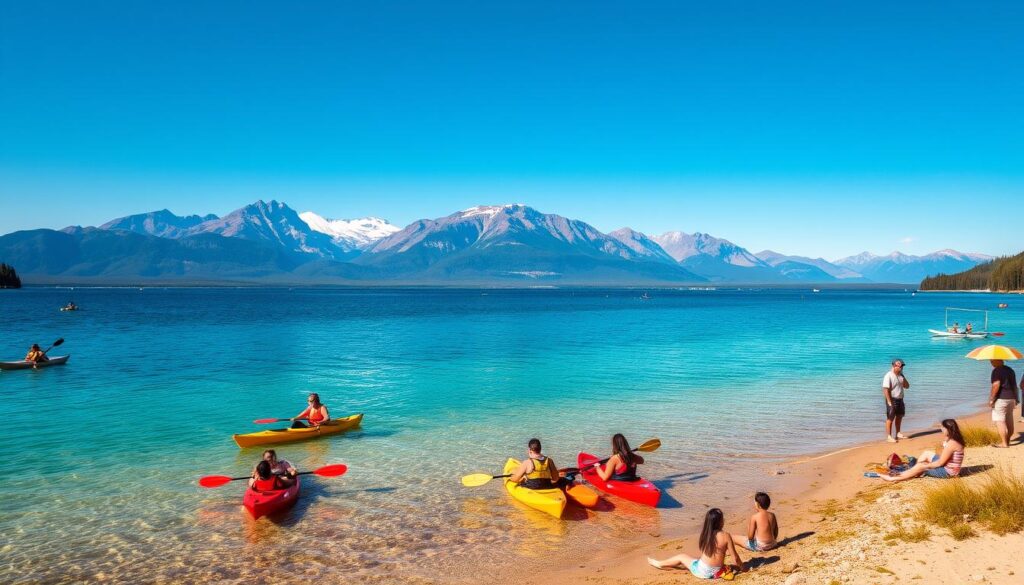
Kayaking and Canoeing Basics
Kayaking and canoeing are popular water-based activities that allow you to explore lakes, rivers, and coastal areas. To get started, it’s essential to learn the basics of paddling and navigation.
Paddling Techniques
Effective paddling involves using the right stroke techniques to propel your kayak or canoe efficiently. Proper paddling not only conserves energy but also enhances your overall experience.
Water Navigation Safety
Understanding water navigation safety is crucial for a safe and enjoyable experience. This includes being aware of water currents, weather conditions, and using appropriate safety gear like life jackets.
Fishing Tips for Beginners
Fishing is another rewarding water-based activity that requires some knowledge and preparation. For beginners, understanding the basics of fishing gear and techniques can significantly improve their chances of success.
Essential Fishing Gear
Having the right fishing gear is essential for a successful fishing experience. This includes choosing the appropriate rod, reel, and bait for the type of fishing you’re doing.
Catch and Release Practices
Catch and release practices are vital for conserving fish populations and maintaining the health of aquatic ecosystems. Handling fish gently and releasing them quickly can help ensure their survival.
Swimming Safety in Natural Waters
Swimming in natural waters can be a refreshing experience, but it comes with its own set of risks. Understanding how to assess water conditions and prevent hypothermia is crucial for safety.
Assessing Water Conditions
Before swimming, it’s essential to assess the water conditions, including checking for strong currents, water temperature, and any potential hazards.
Preventing Hypothermia
Hypothermia can occur when the body loses heat too quickly. Preventing hypothermia involves being aware of the water temperature and taking appropriate measures, such as wearing a wetsuit if necessary.
Wildlife Observation and Photography
Wildlife observation and photography offer a unique opportunity to connect with the natural world. By venturing into the outdoors, individuals can witness the beauty and diversity of wildlife in their natural habitats.
Spotting and Identifying Wildlife
To successfully observe wildlife, one must be able to spot and identify different species. This involves understanding their habitats, behaviors, and characteristics.
Using Field Guides and Apps
Field guides and mobile apps are invaluable tools for identifying wildlife. They provide detailed information on species, including descriptions, habitats, and behaviors. Popular apps like iNaturalist and Merlin Bird ID can help enthusiasts accurately identify the wildlife they encounter.
Best Times for Wildlife Viewing
The best times for wildlife viewing vary depending on the species and location. Generally, early morning and late evening are considered optimal times, as many animals are most active during these periods.
Photography Tips for Nature Enthusiasts
Capturing high-quality wildlife photographs requires a combination of technical skills and an understanding of animal behavior. Here are some tips for nature enthusiasts.
Camera Settings for Outdoor Conditions
Adjusting camera settings according to outdoor conditions is crucial. A fast shutter speed is often necessary to capture moving animals, while a wide aperture can help to create a shallow depth of field, isolating the subject.
Composition Techniques for Landscapes
When photographing wildlife within their natural landscapes, composition techniques such as the rule of thirds can enhance the overall image. Considering the environment and including contextual elements can add depth to the photograph.
Respecting Wildlife Habitats
While observing and photographing wildlife, it is essential to respect their habitats and maintain a safe distance to avoid causing stress or harm to the animals.
Safe Viewing Distances
Maintaining a safe viewing distance is crucial to avoid disturbing wildlife. The specific distance can vary depending on the species, but a general rule is to keep a distance that does not cause the animal to change its behavior.
Understanding Animal Behavior
Understanding animal behavior is key to both successful wildlife observation and photography, as well as respecting their space. Recognizing signs of stress or agitation can help observers and photographers adjust their approach to minimize their impact.
| Tips for Wildlife Observation | Benefits |
|---|---|
| Using field guides and apps | Accurate identification of species |
| Observing at optimal times | Increased chances of spotting active wildlife |
| Maintaining safe viewing distances | Reduced stress on animals |
Outdoor Cooking and Nutrition
Outdoor cooking is an essential skill for anyone looking to explore nature without sacrificing the pleasure of a well-cooked meal. Whether you’re hiking, camping, or simply spending time in your backyard, having the right strategies for meal preparation can enhance your outdoor experience.
Meal Planning for Outdoor Adventures
Effective meal planning is crucial for outdoor adventures. It involves considering the duration of your trip, the number of people you’re cooking for, and the type of activities you’ll be doing.
Calorie and Nutrient Considerations
When planning meals, it’s essential to consider the calorie and nutrient needs of your group. High-energy foods such as nuts, dried fruits, and jerky are excellent choices for outdoor adventures.
Lightweight Food Options
Opting for lightweight, high-calorie foods can help reduce the weight of your backpack while still providing the necessary energy. Examples include dehydrated meals and energy bars.
Cooking Equipment and Techniques
The right cooking equipment can make a significant difference in your outdoor cooking experience. Portable stoves and camping grills are popular choices among outdoor enthusiasts.
Stove Types and Fuel Efficiency
When choosing a stove, consider factors such as fuel efficiency, weight, and ease of use. Canister stoves are popular for their convenience and reliability.
One-Pot Meal Strategies
One-pot meals are a great way to simplify cooking while outdoors. They reduce cleanup and can be very satisfying. Consider meals like stews or pasta dishes.
Food Safety in the Wilderness
Maintaining food safety is critical when cooking outdoors. This involves proper food storage and water purification.
Proper Food Storage
Store food in airtight containers to keep it fresh and protect it from wildlife.
Water Purification Methods
Use methods like boiling, filtering, or chemical treatment to purify water. This ensures that your drinking water is safe and free from pathogens.
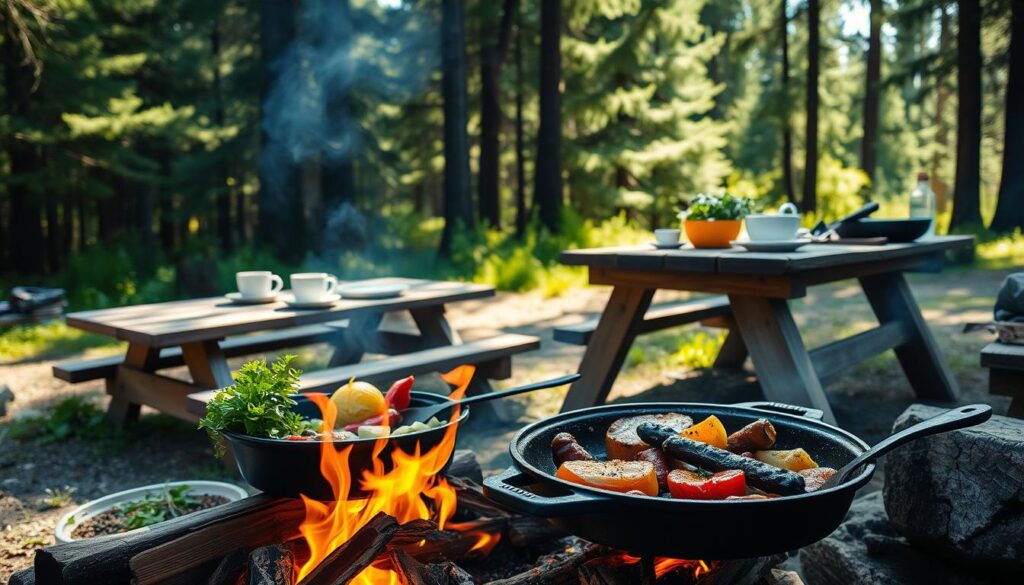
Navigating Challenges in The Outdoors
When exploring the outdoors, being prepared for challenges is key to a successful and enjoyable experience. The great outdoors can be unpredictable, with weather changes, wildlife encounters, and potential injuries being just a few of the challenges adventurers might face.
Weather Changes and Adaptations
Weather conditions can change rapidly in the outdoors, catching adventurers off guard. Being able to recognize the signs of changing weather and knowing how to adapt is crucial.
Recognizing Dangerous Weather Signs
Darkening skies, increasing winds, and dropping temperatures can signal impending bad weather. Being aware of these signs can help you seek shelter before the situation becomes dangerous.
Finding Natural Shelters
Knowing how to identify and use natural shelters such as caves, overhangs, or even groups of trees can provide protection from harsh weather conditions. Look for dry, elevated areas that are less likely to be affected by rain or flash floods.
First Aid Essentials
Accidents can happen even with the best planning. Knowing basic first aid can make a significant difference in outcomes.
Treating Common Outdoor Injuries
Common injuries include cuts, sprains, and burns. Cleaning and dressing wounds, immobilizing sprains, and cooling burns are essential first aid techniques.
Building a Comprehensive First Aid Kit
A well-stocked first aid kit should include bandages, antiseptic wipes, pain relievers, and any personal medications. Regularly checking and updating your kit ensures it’s ready when needed.
Emergency Preparedness
In case of an emergency, being prepared can be lifesaving. This includes having the right equipment and knowing how to use it.
Communication Devices and Protocols
Carrying a reliable communication device such as a satellite phone or a two-way radio can help in calling for help when needed.
Signaling for Help
Knowing how to signal for help using flares, mirrors, or even creating smoke can be crucial in getting rescued. Stay visible and signal during the day to increase your chances of being spotted.
By being prepared for outdoor challenges, adventurers can minimize risks and enjoy their experiences to the fullest. Whether it’s adapting to weather changes, administering first aid, or signaling for help, being knowledgeable and prepared is key.
Family-Friendly Outdoor Activities
Engaging in outdoor adventures with your family can be both fun and educational. The key is to choose activities that are appropriate for the age and interests of your children.
Age-Appropriate Adventures
Different ages require different types of activities. For younger children, simple games and explorations are ideal, while older children can engage in more complex outdoor pursuits.
Toddler and Preschool Activities
For toddlers and preschoolers, outdoor activities can be as simple as going on a nature walk, playing with balls, or having a picnic. These activities help develop their motor skills and encourage an appreciation for nature.
Engaging Teenagers in Nature
Teenagers can enjoy more challenging activities such as hiking, kayaking, or even geocaching. These activities not only provide exercise but also teach valuable outdoor skills.
Keeping Children Engaged in Nature
To keep children engaged, it’s essential to make outdoor activities fun and interactive. This can be achieved through games and challenges that encourage exploration.
Nature Scavenger Hunts
Creating a scavenger hunt list with items found in nature is a great way to keep children engaged. It encourages them to explore and observe their surroundings closely.
Wildlife Tracking Games
Teaching children about wildlife tracking by making it a game can be both fun and educational. It helps them learn about different species and their habitats.
| Activity | Age Group | Skills Developed |
|---|---|---|
| Nature Scavenger Hunt | 6-12 years | Observation, Exploration |
| Wildlife Tracking | 8-14 years | Research, Patience |
| Hiking | 10+ years | Endurance, Navigation |
Teaching Outdoor Skills to Kids
Teaching children outdoor skills is not only about safety; it’s also about fostering a deeper connection with nature.
Basic Navigation Lessons
Teaching basic navigation skills such as reading a map and using a compass is essential for any outdoor adventure.
Safety Rules for Young Explorers
Educating children on safety rules such as staying on designated trails, not approaching wildlife, and being aware of their surroundings is crucial.
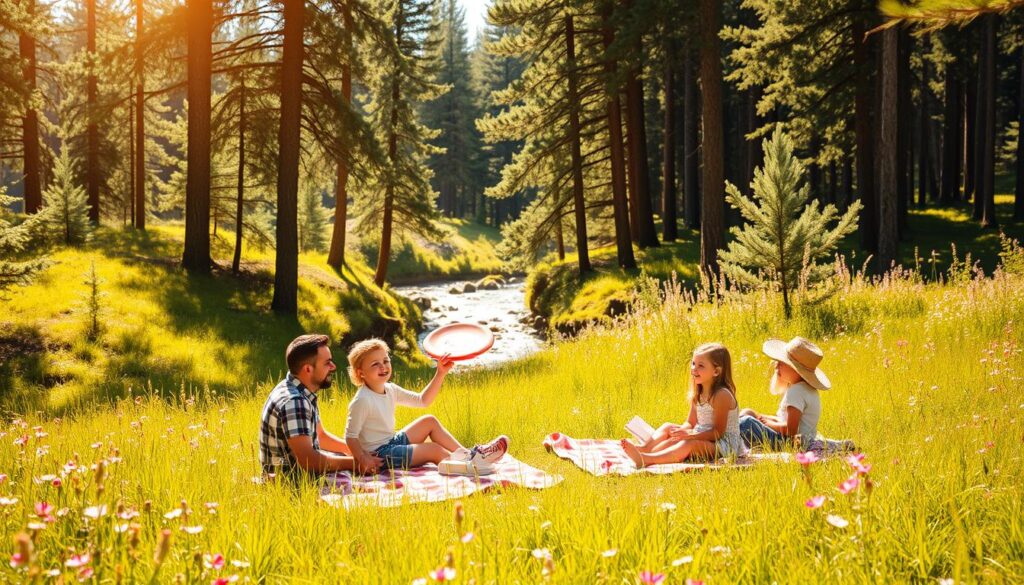
By engaging in these activities and teaching children valuable outdoor skills, families can create lasting memories and foster a lifelong appreciation for nature.
Seasonal Outdoor Experiences
The outdoors transforms with each season, presenting unique opportunities for adventure and exploration. Whether you’re a nature enthusiast or an adventure seeker, understanding the characteristics of each season can enhance your outdoor experiences.
Spring Nature Exploration
Spring is a time of renewal, marked by the blooming of wildflowers and the return of migratory birds. It’s an ideal season for nature walks and exploration.
Wildflower Identification
Spring wildflowers are a delight, with species like trillium and violets adding color to the landscape. Guides and apps can help identify these flowers.
Bird Migration Watching
As birds migrate back to their summer habitats, spring is a prime time for birdwatching. Setting up a bird feeder or going on a guided tour can enhance the experience.
Summer Outdoor Adventures
Summer offers warm weather, making it perfect for a variety of outdoor activities, from hiking and camping to water sports.
Heat Safety Precautions
It’s crucial to stay hydrated and protect yourself from the sun during summer outdoor adventures. Wearing light, breathable clothing and taking regular breaks can help prevent heat-related illnesses.
Night Sky Observation
Summer’s clear skies offer excellent opportunities for stargazing. Finding a dark location away from city lights can enhance the experience.
Fall Foliage and Activities
Fall is renowned for its foliage, as leaves change color, creating vibrant landscapes. It’s also a great time for outdoor activities like hiking and foraging.
Peak Foliage Timing Tips
Timing is everything when it comes to enjoying fall foliage. Checking local reports and forecasts can help plan the perfect trip.
Foraging for Seasonal Edibles
Fall is a good time to forage for wild edibles like mushrooms and nuts. It’s essential to be knowledgeable about what’s safe to eat.
Winter Outdoor Recreation
Winter brings its own set of outdoor activities, including snowshoeing, cross-country skiing, and ice fishing.
Snowshoeing and Cross-Country Skiing
These activities allow you to explore snow-covered landscapes. Proper equipment and safety precautions are necessary.
Cold Weather Safety
Dressing warmly and staying dry are key to enjoying winter outdoor activities safely. Being aware of hypothermia and frostbite risks is also crucial.
| Season | Outdoor Activities | Safety Tips |
|---|---|---|
| Spring | Nature walks, birdwatching | Watch for ticks and slippery paths |
| Summer | Hiking, camping, water sports | Stay hydrated, protect from sun |
| Fall | Hiking, foraging | Be aware of hunting seasons, watch for slippery leaves |
| Winter | Snowshoeing, cross-country skiing | Dress warmly, watch for icy conditions |
Budget-Friendly Outdoor Recreation
Enjoying the great outdoors doesn’t have to break the bank. With some planning and creativity, outdoor enthusiasts can experience nature’s beauty without overspending.
Free and Low-Cost Natural Attractions
Many natural attractions offer free or low-cost access. Some options include:
- National forests
- Local parks
- Beaches
National and State Park Fee-Free Days
Many national and state parks offer fee-free days throughout the year. These events are a great opportunity to explore new parks without the usual entrance fees. For example, the National Park Service offers fee-free days on certain holidays.
Urban Green Spaces and Trails
Urban green spaces and trails are another budget-friendly option for outdoor recreation. These areas often provide a peaceful escape from city life and are easily accessible. Many cities have invested in creating and maintaining these spaces, making them available for public use.
Equipment Rentals and Borrowing Options
For those who don’t want to invest in expensive outdoor gear, rental and borrowing options are available.
Gear Libraries and Co-ops
Some communities have gear libraries or co-ops where members can borrow equipment for a small fee or membership. This is a great way to try out gear before buying.
Second-Hand Outdoor Equipment
Buying second-hand outdoor equipment is another cost-effective option. Many online marketplaces and local outdoor groups offer gently used gear at a fraction of the original price.
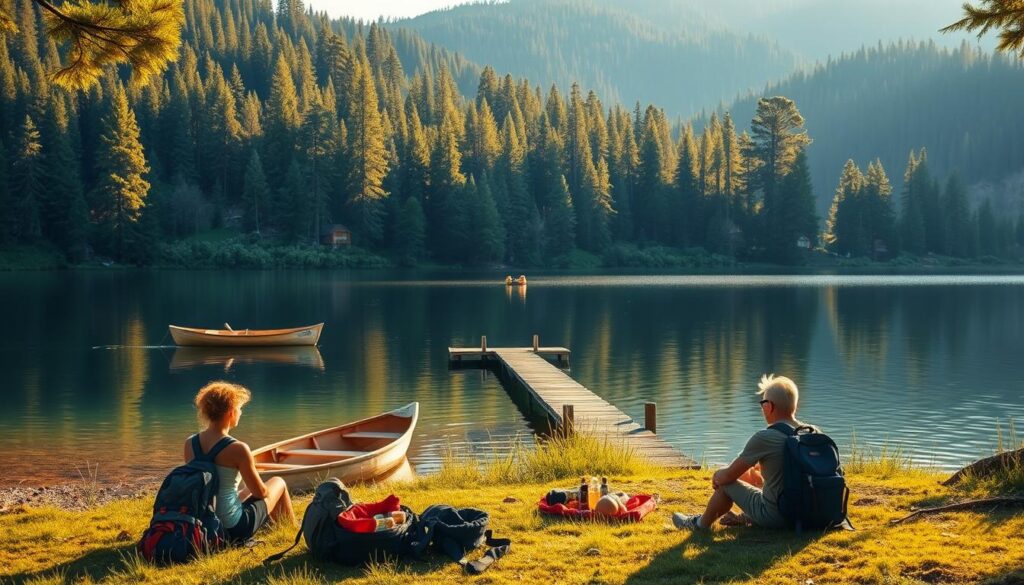
Sustainable Practices for Outdoor Enthusiasts
Outdoor enthusiasts have a unique opportunity to make a positive impact on the environment by adopting sustainable practices. By doing so, they not only preserve the natural beauty of the great outdoors but also ensure that future generations can enjoy the same experiences.
Minimizing Environmental Impact
One of the key aspects of sustainable practices is minimizing environmental impact. This can be achieved through simple actions such as proper waste disposal and staying on designated trails.
Proper Waste Disposal
Proper waste disposal is crucial in maintaining the cleanliness and integrity of natural environments. Outdoor enthusiasts should always carry a small bag to collect their trash and dispose of it appropriately when they return to civilization.
Staying on Designated Trails
Staying on designated trails helps prevent erosion and protects sensitive habitats. It’s a simple yet effective way to minimize one’s footprint in the outdoors.
Supporting Conservation Efforts
Supporting conservation efforts is another vital aspect of sustainable practices. This can be done through volunteering for conservation projects or participating in citizen science initiatives.
Volunteer Opportunities
Many organizations offer volunteer opportunities for outdoor enthusiasts to participate in conservation efforts. These can range from trail maintenance to wildlife conservation projects.
Citizen Science Projects
Citizen science projects allow individuals to contribute to scientific research and conservation efforts. These projects can provide valuable data that helps in understanding and protecting natural environments.
By embracing these sustainable practices, outdoor enthusiasts can play a significant role in preserving the natural world.
| Sustainable Practice | Impact | Action |
|---|---|---|
| Proper Waste Disposal | Reduces pollution and maintains cleanliness | Carry a trash bag and dispose of waste properly |
| Staying on Designated Trails | Prevents erosion and protects habitats | Follow trail signs and stay on marked paths |
| Volunteer Opportunities | Contributes to conservation efforts | Look for local conservation projects to volunteer |
Conclusion: Embracing the Outdoor Lifestyle
Embracing the outdoor lifestyle is a journey that enriches our lives, fostering a deeper connection with nature and promoting overall well-being. Through the tips and tricks shared in this article, you’re now better equipped to explore the outdoors with confidence.
From essential gear to outdoor cooking, and from hiking fundamentals to wildlife observation, the great outdoors offers a wealth of experiences waiting to be discovered. As you continue on your nature exploration journey, remember to respect the environment and preserve its beauty for future generations.
By adopting sustainable practices and supporting conservation efforts, you can play a vital role in protecting the natural world. So, get outside, breathe in the fresh air, and let the beauty of the outdoors inspire you to live a more adventurous, balanced lifestyle.

